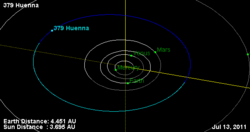Astronomy:379 Huenna
 Orbital diagram | |
| Discovery[1] | |
|---|---|
| Discovered by | Auguste Charlois |
| Discovery date | 8 January 1894 |
| Designations | |
| (379) Huenna | |
| Pronunciation | /hjuːˈɛnə/ |
| Named after | Ven |
| 1894 AQ; A895 DB; A911 BA; 1948 XM | |
| Minor planet category | Main belt (Themis) |
| Orbital characteristics[1] | |
| Epoch 31 July 2016 (JD 2457600.5) | |
| Uncertainty parameter 0 | |
| Observation arc | 122.26 yr (44656 d) |
| |{{{apsis}}}|helion}} | 3.7186 astronomical unit|AU (556.29 Gm) |
| |{{{apsis}}}|helion}} | 2.5540 AU (382.07 Gm) |
| 3.1363 AU (469.18 Gm) | |
| Eccentricity | 0.18567 |
| Orbital period | 5.55 yr (2028.7 d) |
| Mean anomaly | 126.109° |
| Mean motion | 0° 10m 38.82s / day |
| Inclination | 1.6699° |
| Longitude of ascending node | 172.036° |
| 179.961° | |
| Known satellites | 1 (5.8±1.2 km)[2] |
| Physical characteristics | |
| Mean diameter | 92.33±1.7 km (IRAS)[1] 98±3 km[2] |
| Mass | (3.83±0.19)×1017 kg[2][3] |
| Mean density | 0.9±0.1 g/cm3[2][3] 1.2 g/cm3[4][5] |
| Rotation period | 14.141 h (0.5892 d)[1] |
| Geometric albedo | 0.0587±0.002[1] |
| C[3] | |
| Absolute magnitude (H) | 8.87[1] |
Huenna (minor planet designation: 379 Huenna) is a large asteroid orbiting in the asteroid belt. It is part of the Themis family, and thus a C-type asteroid and consequently composed mainly of carbonaceous material.
It was discovered by Auguste Charlois on 8 January 1894 in Nice. It is the Latin name for the Swedish island of Ven, the site of two observatories. This island is where Tycho Brahe built his observatory.[6]
Satellite
A satellite, 7 km across and designated S/2003 (379) 1, was discovered on 14 August 2003 by Jean-Luc Margot using the Keck II adaptive optics telescope at Mauna Kea.[7] The moon orbits 3400±11 km away in 80.8±0.36 d with an eccentricity of 0.334±0.075.[5] The system is loosely bound[4] as Huenna has a Hill sphere with a radius of about 20,000 km.[2]
References
- ↑ 1.0 1.1 1.2 1.3 1.4 1.5 "JPL Small-Body Database Browser: 379 Huenna (1894 AQ)". Jet Propulsion Laboratory. https://ssd.jpl.nasa.gov/sbdb.cgi?sstr=379.
- ↑ 2.0 2.1 2.2 2.3 2.4 Marchis, Franck; P. Descamps; J. Berthier; D. hestroffer; F. vachier; M. Baek et al. (2008). "Main Belt Binary Asteroidal Systems With Eccentric Mutual Orbits". Icarus 195 (1): 295–316. doi:10.1016/j.icarus.2007.12.010. Bibcode: 2008Icar..195..295M.
- ↑ 3.0 3.1 3.2 Jim Baer (12 December 2010). "Recent Asteroid Mass Determinations". Personal Website. http://home.earthlink.net/~jimbaer1/astmass.txt.
- ↑ 4.0 4.1 Franck Marchis (May 2005). "379 Huenna and S/2003 (379) 1". UCB. http://astro.berkeley.edu/~fmarchis/Science/Asteroids/Huenna.html.
- ↑ 5.0 5.1 Wm. Robert Johnston (25 November 2008). "(379) Huenna and S/2003 (379) 1". Johnston's Archive. http://www.johnstonsarchive.net/astro/astmoons/am-00379.html.
- ↑ Peebles, Curtis (2016), Asteroids: a History, Smithsonian, p. 159, ISBN 9781944466046, https://books.google.com/books?id=RbDkCwAAQBAJ&pg=PT159.
- ↑ "IAUC 8182: S/2003 (379) 1; 2003he, 2003hf; C/2003 H1; C/2001 Q4". IAU Central Bureau for Astronomical Telegrams. 15 August 2003. http://www.cbat.eps.harvard.edu/iauc/08100/08182.html.
External links
- Lightcurve plot of 379 Huenna, Palmer Divide Observatory, B. D. Warner (2010)
- Asteroids with Satellites, Robert Johnston, johnstonsarchive.net
- Asteroid Lightcurve Database (LCDB), query form (info )
- Dictionary of Minor Planet Names, Google books
- Asteroids and comets rotation curves, CdR – Observatoire de Genève, Raoul Behrend
- Discovery Circumstances: Numbered Minor Planets (1)-(5000) – Minor Planet Center
- Orbits of Binary Asteroids with Adaptive Optics (VLT images, archived)
- 379 Huenna at AstDyS-2, Asteroids—Dynamic Site
- 379 Huenna at the JPL Small-Body Database
 |


